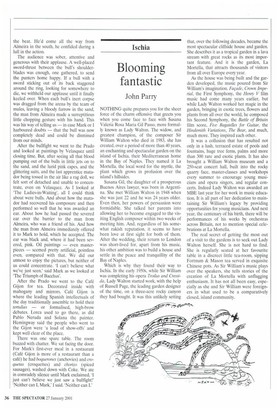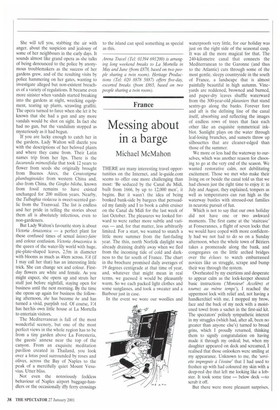Blooming fantastic
John Parry
NOTHING quite prepares you for the sheer force of the charm offensive that greets you when you come face to face with Susana Valeria Rosa Maria Gil Passo, more formally known as Lady Walton. The widow, and greatest champion, of the composer Sir William Walton who died in 1983, she has created, over a period of more than 40 years, an enchanting and spectacular garden on the island of Ischia. their Mediterranean home in the Bay of Naples. They named it La Mortella, the local word for the myrtle, the plant which grows in profusion over the island's hillsides.
Susana Gil, the daughter of a prosperous Buenos Aires lawyer, was born in Argentina. She met William Walton in 1948 when she was just 22 and he was 24 years older. Even then, her powers of persuasion were formidable. She talked her parents into allowing her to become engaged to the visiting English composer within two weeks of meeting him. And, regardless of his somewhat rakish reputation, it seems to have been love at first sight for both of them. After the wedding, their return to London was short-lived for, apart from his music, his other ambition was to build a house and settle in the peace and tranquillity of the Bay of Naples.
Which is why they found their way to Ischia. In the early 1950s, while Sir William was completing his opera Troilus and Cressida, Lady Walton started work, with the help of Russell Page, the leading garden designer of the time, on a three-acre rocky canyon they had bought. It was this unlikely setting that, over the following decades, became the most spectacular cliffside house and garden. She describes it as a tropical garden in a lava stream with great rocks as its most important feature. And it is the garden, La Mortella, that attracts thousands of visitors from all over Europe every year.
As the house was being built and the garden developed, the music poured from Sir William's imagination. Facade, Crown Imperial, the First Symphony, the Henry V film music had come many years earlier, but while Lady Walton worked her magic in the garden, bringing in exotic trees, flowers and plants from all over the world, he composed his Second Symphony, the Battle of Britain film score, Five Bagatelles for Guitar, the Hindemith Variations, The Bear, and much, much more. They inspired each other.
It was a collusion that has resulted not only in a lush, terraced estate of pools and fountains, huge tree ferns, palms and more than 300 rare and exotic plants. It has also brought a William Walton museum and a 250-seat concert hall, built into the rocky quarry face, master-classes and workshops every summer to encourage young musicians and opera singers, and regular concerts. Indeed Lady Walton was awarded an MBE last year for her work in music education. It is all part of her dedication to maintaining Sir William's legacy by providing opportunities for young musicians. And next year, the centenary of his birth, there will be performances of his works by orchestras across Britain, not to mention special celebrations at La Mortella.
The real secret of getting the most out of a visit to the gardens is to seek out Lady Walton herself. She is not hard to find. She is regularly seated at her favourite table in a discreet little tea-room, sipping Fortnum & Mason tea served in exquisite Chinese pots. As Sir William's music plays over the speakers, she tells stories of the creation of La Mortella with unflagging enthusiasm. It has not all been easy, especially as she and Sir William were foreigners in what used to be a comparatively closed, island community. She will tell you, stabbing the air with anger, about the suspicion and jealousy of some of her neighbours in the early days. It sounds almost like grand opera as she talks of being denounced to the police by anonymous troublemakers as the success of her gardens grew, and of the resulting visits by police hammering on her gates, wanting to investigate alleged but non-existent breaches of a variety of regulations. It became even more sinister when vandals started breaking into the gardens at night, wrecking equipment, tearing up plants, scrawling graffiti. The opera turned to farce when she let it be known that she had a gun and any more vandals would be shot on sight. In fact she had no gun, but the vandalism stopped as mysteriously as it had begun.
If you are lucky enough to catch her in the gardens, Lady Walton will dazzle you with the descriptions of her beloved plants and where they came from. Their Latin names trip from her lips. There is the Jacaranda mimosifolia that took 12 years to flower from seeds she originally brought from Buenos Aires, the Ceratostigrna plumbaginoides from western China and, also from China, the Gingko biloba, known from fossil remains to have existed unchanged for 200 million years. Nearby, the Tulbaghia violacea is sweet-scented garlic from the Transvaal. The list is endless and her pride in telling the stories about them all is absolutely infectious, even to non-gardeners.
But Lady Walton's favourite story is about Victoria Arnazonica — a perfect plant for these confused times of sexual laissez-faire and colour confusion. Victoria Amazonica is the queen of the water-lily world with huge, pie-plate-shaped leaves, 2.5m in diameter with blooms as much as 40cm across. VA (if I may call her that) has an interesting little trick. She can change sex and colour. Firstday flowers are white and female. As you might expect, she opens up and struts her stuff just before nightfall, staying open for business until the next morning. By the time she opens up again for business the following afternoon, she has become he and has turned a vivid, purplish red. Of course, VA has her/his own little house at La Mortella to entertain visitors.
The Mediterranean is full of the most wonderful scenery, but one of the most perfect views in the whole region has to be from a tiny garden above La Foresteria, the guests' annexe near the top of the canyon. From an exquisite meditation pavilion created in Thailand, you look over a lotus pool surrounded by roses and olives, across the Bay of Naples to the peak of a mercifully quiet Mount Vesuvius. Utter bliss.
Not even the notoriously feckless behaviour of Naples airport baggage-handlers or the occasionally iffy ferry crossings to the island can spoil something as special as this.
Arena Travel (Tel: 01394 691200) is arranging long weekend breaks to La Mortella in May and June (from £878, based on two people sharing a twin room). Heritage Productions (Tel: 020 8878 5887) offers five-day, escorted breaks (from £865, based on two people sharing a twin room).























































































 Previous page
Previous page